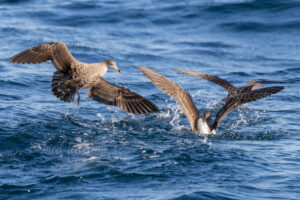 This time the off-shore waters of the west coast of Ireland with Blacksod Sea Safari is going on. On the trip to the Atlantic we pass the island of Inishkea. Eventually we are surrounded by the vastness of the Atlantic Ocean.In the distance, I spot the distinctive white wings of Northern Gannets (Morus bassanus) diving into the water. Their precision and speed make it seem like something remarkable is happening beneath the surface. I suspect there are Shearwaters mixed in with them, though it’s hard to tell from this distance. A school of dolphins, likely Common Dolphins (Delphinus delphis), is stirring up a school of fish, causing the entire scene to come alive. The chaotic beauty of nature is unfolding before ours eyes, as if orchestrated by some unseen force.
This time the off-shore waters of the west coast of Ireland with Blacksod Sea Safari is going on. On the trip to the Atlantic we pass the island of Inishkea. Eventually we are surrounded by the vastness of the Atlantic Ocean.In the distance, I spot the distinctive white wings of Northern Gannets (Morus bassanus) diving into the water. Their precision and speed make it seem like something remarkable is happening beneath the surface. I suspect there are Shearwaters mixed in with them, though it’s hard to tell from this distance. A school of dolphins, likely Common Dolphins (Delphinus delphis), is stirring up a school of fish, causing the entire scene to come alive. The chaotic beauty of nature is unfolding before ours eyes, as if orchestrated by some unseen force.
As we get closer, it becomes clear that the northern gannets are in the majority, their white and yellow plumage standing out against the blue of the sea. But among them, I begin to notice the more subtle, darker forms of Sooty Shearwaters (Ardenna grisea). One particularly determined individual has just managed to catch a Sand Eel (Ammodytes spp.) and is struggling to swallow it quickly before flying away from us. It’s a common scene among seabirds: catch, swallow, flee. It’s the only way to survive in such a competitive environment.
As I continue to observe, more species of Shearwaters come into focus. There’s an almost eerie activity as Great Shearwaters (Ardenna gravis), Cory’s Shearwaters (Calonectris borealis), Sooty Shearwaters (Ardenna griseus), Northern Fulmar (Fulmarus glacialis) und only a few Manx Shearwater (Puffinus puffinus) glide just above the waves. Their graceful, almost effortless flight contrasts with the occasional chaos when they dive after fish or try to avoid competition. The surface of the water is teeming with life, both above and below, and the frenzy is mesmerizing.
In between the birds, dolphins frequently break the surface, their fins slicing through the water. Each time they do, the gannets and shearwaters adjust their positions, waiting for the next opportunity to dive. Photographing this wild dance is a challenge, with the constant movement and rapid changes in direction. Every moment feels fleeting, as if the whole scene could vanish as quickly as it began.
This symbiotic relationship between dolphins and seabirds, particularly in their joint pursuit of prey, is a fascinating example of how nature’s rhythms are intricately connected. The gannets, shearwaters, and dolphins, each with their own role, collaborate in a way that seems almost magical. For bird enthusiasts, witnessing these moments in person is both rare and unforgettable. You might seabirds from the coastal cliffs as well. But if you really want to get close to seabirds, the pelagic species – whether to enjoy the incomparable feeling of immediate connection at eye level, be part of the creative chaos described above or just to take close-up photos of these elegant flyers – you have to rent a boat. A trip should last at least 3 hours. It still costs almost € 400 – 500. It was a fabulous trip to see the vast Atlantic with Blacksod Sea Safari on 2 beautiful days. To see and photograph the Shearwaters and Stormpetrels was really amazing. Definitely well worth the money. Ask for Toby as the Skipper. Blacksod Sea Safari is highly recommended.
In order to meet the growing demand for top images of the rarer species of Palaearctic Bird-lens.com has specifically made trips to remote places. Additionally every chance is used, if a rare bird is around the homeground. This to do everything to ensure excellent photos of the Birds of the Western Palearctic. The yield of pictures also of rare Western Palaearctic birds is very good. There are other nice images of birds, that you will find behind the tab “Picture Shop“. Just give a notice if you need a picture of a bird which is not online.
It was great to host Johannes on this trip and his description is both wonderful and exact, it unfolded as he describes. Indeed such events are often hard to find and certainly can never be promised, however they are certainly worth the wait as can be confirmed by Johannes’s superb photos.
Hi Toby, thanks a lot for your comment and the trip. It was marvellous. I will come back for sure. Cheers